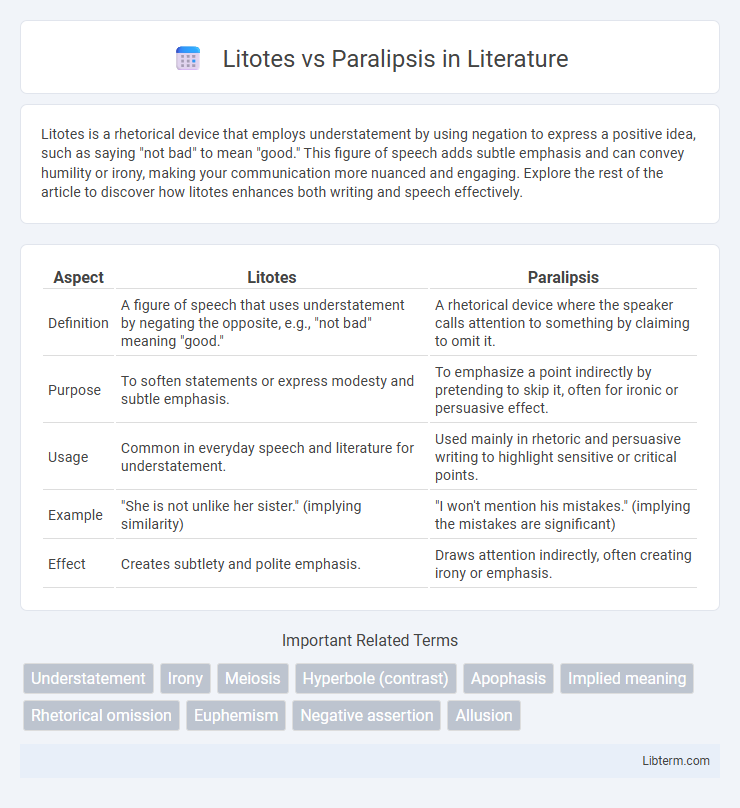Litotes is a rhetorical device that employs understatement by using negation to express a positive idea, such as saying "not bad" to mean "good." This figure of speech adds subtle emphasis and can convey humility or irony, making your communication more nuanced and engaging. Explore the rest of the article to discover how litotes enhances both writing and speech effectively.
Table of Comparison
| Aspect | Litotes | Paralipsis |
|---|---|---|
| Definition | A figure of speech that uses understatement by negating the opposite, e.g., "not bad" meaning "good." | A rhetorical device where the speaker calls attention to something by claiming to omit it. |
| Purpose | To soften statements or express modesty and subtle emphasis. | To emphasize a point indirectly by pretending to skip it, often for ironic or persuasive effect. |
| Usage | Common in everyday speech and literature for understatement. | Used mainly in rhetoric and persuasive writing to highlight sensitive or critical points. |
| Example | "She is not unlike her sister." (implying similarity) | "I won't mention his mistakes." (implying the mistakes are significant) |
| Effect | Creates subtlety and polite emphasis. | Draws attention indirectly, often creating irony or emphasis. |
Introduction to Litotes and Paralipsis
Litotes is a rhetorical device that employs understatement by using double negatives or negations to express a positive idea subtly. Paralipsis involves deliberately emphasizing a point by stating that it will not be mentioned, drawing attention through apparent omission. Both techniques manipulate attention and meaning, serving distinct persuasive functions in discourse.
Defining Litotes: Subtle Understatement
Litotes is a rhetorical device employing subtle understatement by negating the opposite of a statement to convey affirmation gently, often using phrases like "not bad" to mean "good." This figure of speech enhances emphasis through restraint, making it a powerful tool for expressing modesty or irony without overt exaggeration. Litotes contrasts with paralipsis, which involves drawing attention to a subject by claiming to ignore it.
Explaining Paralipsis: Emphasizing by Omission
Paralipsis is a rhetorical device where a speaker or writer emphasizes a point by deliberately omitting or pretending to omit it, thereby drawing attention to it indirectly. This technique often involves stating that something will not be mentioned while actually highlighting it, creating an effect of subtle emphasis through strategic silence. By leveraging omission, paralipsis engages the audience's curiosity and amplifies the significance of the omitted subject in persuasive communication.
Historical Origins and Literary Roots
Litotes originated in ancient Greek rhetoric, where it was employed as a form of understatement by affirming a point through negating its opposite, prominently used in classical literature by playwrights like Aristophanes. Paralipsis stems from classical rhetoric as well, particularly emphasized in Roman oratory, where speakers highlighted a subject by professing to omit it, famously utilized by Cicero to draw attention subtly. Both devices have deep roots in classical texts, serving as persuasive strategies to influence audiences while maintaining ironic or indirect tones.
Key Differences Between Litotes and Paralipsis
Litotes employs deliberate understatement by negating the opposite, often resulting in a mild or ironic expression, while paralipsis involves drawing attention to something by explicitly stating that it will not be mentioned. Litotes uses linguistic negation as a rhetorical device to affirm a positive attribute subtly, whereas paralipsis leverages strategic omission to emphasize or highlight a topic indirectly. The primary difference lies in litotes' use of understatement through negation versus paralipsis' method of highlighting through deliberate omission.
Common Uses in Rhetoric and Literature
Litotes employs understatement by negating the opposite, often used to convey modesty or emphasize a point indirectly, such as saying "not bad" to mean "good." Paralipsis involves deliberately drawing attention to something by claiming to omit it, effectively highlighting a subject while pretending to ignore it in rhetoric and literature. Both devices create subtle emphasis, with litotes softening statements and paralipsis sharpening focus through strategic omission.
Examples of Litotes in Classic and Modern Texts
Litotes is a figure of speech that employs understatement by using double negatives or negation to affirm a positive, as seen in classic texts like Shakespeare's Macbeth with the line "not insignificant" to emphasize importance. Modern examples include phrases such as "not bad" or "no small feat," commonly used to subtly express praise or acknowledgment. This rhetorical device contrasts with paralipsis, which involves drawing attention to something by pretending to omit it.
Examples of Paralipsis in Famous Speeches and Writings
Paralipsis appears prominently in famous speeches such as Cicero's oration against Antony, where he claims he will not discuss Antony's misdeeds while highlighting them extensively. Abraham Lincoln's Gettysburg Address uses paralipsis subtly by stating he will not dedicate the battlefield, yet his words consecrate it deeply. In Shakespeare's plays, characters often employ paralipsis to underscore points indirectly, enhancing rhetorical impact by claiming to pass over certain details they emphasize instead.
Effectiveness and Purpose in Communication
Litotes employs deliberate understatement by negating the opposite, enhancing subtlety and irony in communication to create emphasis through restraint. Paralipsis draws attention by explicitly stating that something will be omitted, effectively highlighting topics indirectly and engaging the audience's curiosity. Both rhetorical devices strategically influence perception: Litotes softens claims to appear modest or tactful, while Paralipsis emphasizes information by feigning omission.
Choosing the Right Device: Contexts and Considerations
Choosing the right rhetorical device between litotes and paralipsis depends on the desired emphasis and subtlety in communication. Litotes employs understatement through double negatives to create a modest or ironic effect, often enhancing persuasion by softening strong statements. Paralipsis draws attention by pretending to omit information, making it effective for highlighting overlooked details or framing controversial points without direct confrontation.
Litotes Infographic

 libterm.com
libterm.com